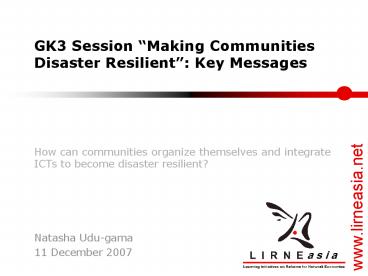GK3 Session Making Communities Disaster Resilient: Key Messages - PowerPoint PPT Presentation
1 / 10
Title:
GK3 Session Making Communities Disaster Resilient: Key Messages
Description:
... sustainability. Build upon community capacity created through this pilot: continuity = sustainability ... What specific ways can sustainability be achieved? ... – PowerPoint PPT presentation
Number of Views:57
Avg rating:3.0/5.0
Title: GK3 Session Making Communities Disaster Resilient: Key Messages
1
GK3 Session Making Communities Disaster
Resilient Key Messages
- How can communities organize themselves and
integrate ICTs to become disaster resilient? - Natasha Udu-gama
- 11 December 2007
2
Decision and Message Relay in Community-based
System
Sarvodaya Community Disaster Management Center
(SCDMC)
Communications Providers
Sarvodaya Communities
3
Hazard Information Hub Standard Procedures
The HIH will not issue messages that provide
specific instructions to local first responders,
except those that might be relayed directly from
the government.
HIH-Monitors at HIH creating and issuing Alerts
4
Performance of the Hazard Information Hub
- Benchmark
- 95 Reliability and Effectiveness
- Current Performance
- Reliability 78
- Effectiveness 83
- Recommendations
- Need to setup better system to force HIH Monitor
to acknowledge receipt of alert - Develop a single input multiple output software
application to speedup relaying of alert via
multiple ICTs to the communities i.e. P2P
Multilanguage CAP Broker
5
Community Organization ICTs
6
- Current Performance
- Reliability 64
- Effectiveness 10
- Given the complexities in communities 65
reliability is tolerable but bench mark should be
85 - Effectiveness can be improved if and only if
entire community participates in training and
simulations effectiveness is low because very
few participated - Effectiveness can be improved if community is
prepared for all-hazards communities prepared
for only tsunami evacuations
7
Visions, Innovations and Trends
- Vision in Sri Lanka Active, empowered
disaster-resilient communities - Vision for South Asia A consistent, streamlined
regional system for communities to receive and
process hazard information - Innovation Community resiliency can be achieved
through a combination of training and technology - Trends
- Resiliency puts the onus on community
- Bottom-up approach
- How can a community-based system strengthen
national systems?
8
Lessons Learned
- Interactive training is essential
- Community organization is advisable especially
with more advanced ICTs - Participation is integral to a community-based
hazard warning system - With these communities will become disaster
prepared
9
Priorities/Potential for Action
- Determine a viable, continuous funding
sourceinternal revenue gt sustainability - Build upon community capacity created through
this pilot continuity gt sustainability - Strengthen Hazard Information Hubreliable
information source gt sustainability - Sustainability Resiliency!
10
Questions for Further Investigation
- Are there other factors essential to achieving
community disaster resiliency? - How can ICTs best promote community disaster
resiliency? - What specific ways can sustainability be
achieved? - How can a community-based hazard information
system be regionalized?































